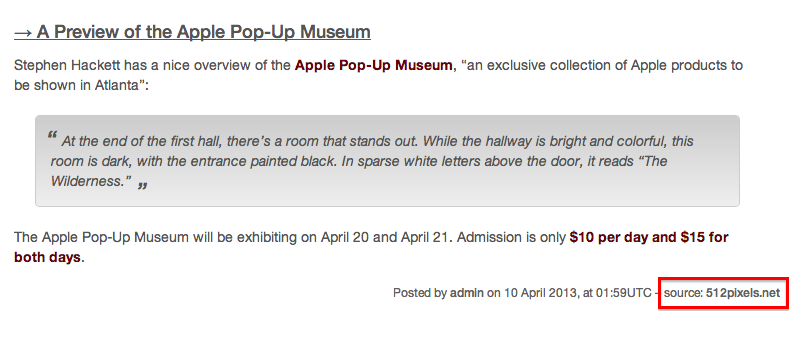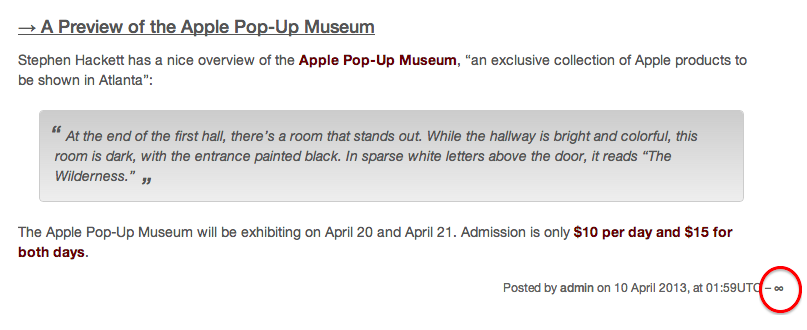You may have noticed that I haven’t written much lately. In mid-March, I decided I needed to take some time off the site to rest and focus on some ideas and changes for MacStories that I’ve been thinking about for quite a while. I came to the conclusion that I need to be able to share more links to interesting news, apps, and articles here on MacStories. I want MacStories to be the place where readers can find our own articles as well as cool stuff produced by others.
Essentially this means two things for the site:
- The style and pace of MacStories’ articles won’t change.
- There is a new format for linked items.
In previous versions of the site, we had a specific style for what we’d call “linked posts”. You can find an archive in our Links category. It used to be that linked posts would have a bounding box around them to differentiate them from regular posts; a clickable link icon; a different styling for the title; and an additional “read more” link to the original source. I believe the old linked posts were aesthetically pleasant and consistent with the rest of the site, but they had two major shortcomings, one of which I regard, in hindsight, as a significant flaw: linked posts didn’t look good unless they were also accompanied by a few paragraphs of text (example). More importantly, they didn’t allow the reader to easily click/tap to get to the source.
The second shortcoming was a hinderance to the idea of linked post itself: linking to someone else is useless if you don’t give the reader an easy enough way to reach the destination. While the link icon was clickable and we always made sure to put a link in the body in addition to the “read more” button, feedback from readers over the years told us that sometimes the best solution is to use a big, unmistakably clickable link that would look the same across every linked post. Readers asked for a consistent link that would always be in the same place and yet also clearly different from MacStories’ own articles. Inevitably, this means we have to change the format of our linked posts.
As I’ve stated in various podcast appearances in the past year, I want MacStories to be different from the typical Apple-related website that’s publishing news, rumors, and reviews of every single app that comes out on the App Store. I want to write about things that I care about and that I’m genuinely interested in. I want my team to find their own things – opinions or apps – that they care about and think would be beneficial to MacStories’ readers. As Apple keeps growing and thousands of new developers start writing apps for OS X and iOS devices, I believe in the importance of quality reviews and opinions from people who spend time discovering content worth of someone else’s attention.
We can only produce so many good – I hope sometimes even great – articles before falling into the psychological trap of having to write dozens of mediocre daily entries just to please advertisers and Google Analytics. I don’t want MacStories to be blindly guided by an unnerving race towards the highest pageviews. Put simply, I want to make money to make more movies.
I’ve been aware of the fact that while I tend to carefully handpick the topics I want to feature on MacStories, I typically share links to interesting things created by others on Twitter. Tweeting a link is easy and it provides immediate feedback in the form of replies, faves, and retweets. So that was my plan: every time someone had created an app or published an article that I knew my readers would like but to which I had nothing to add, I’d tweet it. Take the difference between our Links archive and my own tweets as an example.
I used to be against the idea of a linked list such as the one pioneered by John Gruber’s Daring Fireball and later also successfully applied by writers like Jim Dalrymple and Shawn Blanc. It almost felt like “stealing” pageviews from other authors when I could have just sent a quick tweet. The tweet perfectly fulfilled the two points I mentioned above: it allowed readers to easily click through and I didn’t have to greatly expound upon a topic just to make a link look right on MacStories.
And that’s exactly why I took a break from writing last month. I wanted time to think about a change for our link format and whether I’d be comfortable with it, coming to the conclusion that I am doing a disservice to our readers by simply tweeting a link and not posting it on the site.
There are various reasons behind my conclusion; a few salient points:
- Like Shawn noted, tweets are ephemeral, and websites are more static. How many of you go through hours of your Twitter timeline to see what I tweeted? On the other hand, how many of you visit your favorite weblog to see what a writer posted or discovered on the Internet today? Which process is faster and easier to sift through? I want MacStories to feature both original content and links to other websites that we have discovered, evaluated, and deemed worthy of your attention.
- If you don’t want to visit MacStories to scroll through a list of links, you’ll still be able to follow @macstoriesnet and click through the items that interest you.
- Because we are very selective with the things we want to write about, being able to post more links on the site allows us to keep the site alive without giving the impression that we don’t care about MacStories. I am always working for the site, always reading and researching, and always asking myself whether an app or news item is worthy of my readers’ consideration. And yet there’s also stuff that I didn’t make but that I can’t post on the site because I don’t think the existing format is right. During periods where news is short and app releases I’m interested in are few, I can’t come out with a Pythonista story every day. But rest assured – we’ll be equally selective with links.
- My personal Twitter account is not the best place for links. Why should I put links alongside my own jokes and observations? Twitter is the water cooler, but the site is where I’m serious. People who create quality stuff deserve quality attention.
- People shouldn’t be forced to follow the @viticci account on MacStories on Twitter. Admittedly, that’s where I used to share most of the links to other people’s articles or information related to Apple software updates and App Store changes. Moving MacStories-related links from Twitter to MacStories will likely disappoint some of my followers, but it’s a trade-off: I want to be a writer with a website, not a professional Twitter user.
- I want to control my own content, even the quick links with two words of added commentary. What if Twitter will someday decide to delete all my tweets? I agree with the notion it’s best to own and control the primary technologies that you use. And that’s what I’m doing with links.
- Lastly, MacStories’ audience is large enough to give links more exposure if those links are available on a website rather than some Italian guy’s Twitter stream. Some bloggers are afraid of directing readers to other websites because they fear they may lose them. I want my readers to easily reach other websites, giving pageviews to other people. It sounds crazy, but I know my readers trust me when it comes to writing and discovering good content. I am not afraid of sending them around the interwebs: in fact, I very much look forward to helping other writers get the exposure they deserve.
The new linked items aren’t an excuse to fill the site with content that doesn’t fit with MacStories’ themes, editorial guidelines, and stories.
The new format will allow us to reign in links our readers had to catch up through tweets or retweets from @macstoriesnet. With either a few words or a few paragraphs, linked items can now sit in-between normal content on the site, driving more traffic to external sources while making MacStories a better place to showcase stuff we think readers would be interested in.
In practical terms, it means links like these will be presented on the site with a quote, a short accompanying paragraph of commentary, a few paragraphs, or maybe just two words depending on what we see fit.
Linked items will be clearly distinct from regular posts through the use of a smaller, underlined title that becomes red on mouseover (to indicate it’s a link), an arrow character to further hint at the link nature of the title, and the source’s domain name shown at the bottom (alongside author information and time of publication).
On the site’s homepage, a link icon will let you easily open the permalink of our linked item. If you’re familiar with the way linked items appear on Daring Fireball or The Loop, you’ll know how these work. We have put a lot of thought into the format and we believe that, ultimately, this the best choice for us and MacStories readers.
I wanted to take the opportunity to personally thank you, our readers, for your continued support of MacStories in the past year. My gratitude also goes to the MacStories team, who have kept the site fresh and profitable in times of difficulty and stress. I believe it was right to publicly explain in the detail a simple format change for linked items because our readers deserve to know MacStories’ goal is still the same: to be a honest, helpful resource for news, reviews, and opinion that is worth of our readers’ attention.
The best way to get all the latest MacStories posts is to either follow @macstoriesnet on Twitter or subscribe to our RSS feed. If you don’t want to see linked items in your RSS reader, we have created a new feed with all articles except linked items: you can find it here.
While we’ll be doing our best to discover cool stuff, we are dependent upon our readers and the developer community to find great apps and articles worth writing about. Send us tips on Twitter through @macstoriesnet (or my personal account, @viticci) or with an email at tips@macstories.net and don’t be shy – we welcome self submissions.
We hope that you’ll like this small tweak to the site and our renewed focus on writing and discovering quality content. Thank you for reading MacStories.



